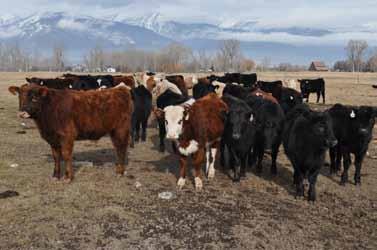Agriculture Magazine, September 2020 - Page 5
St. John’s Wort is rapidly spreading weed in Ravalli County Ravalli County Weed District
St. Johnswort is a rapidly spreading weed in Ravalli County, primarily on the west side of the valley. The Ravalli County Weed District works hard to educate our landowners on how to control this noxious weed on their own property. Here is some great information about this noxious toxic plant. St. John’s wort, also known as “common St. Johnswort”, “Klamath weed”, “common goatweed”, and “tipton weed.” It prefers poor dry, gravelly, or sandy soil in full sun. It can be found primarily in right-of-ways, roadsides, meadows, dry pasSt. Johnswort tures, rangelands, fields, open woods, waste places, and disturbed ground. The perennial, upright forb typically grows one to two feet tall with numerous stems and somewhat woody at the plants base. Stems are reddish in color and can be single or multiple with two opposite longitudinal ridges. The stems can branch many times towards the top of the plant. Leaves are lance-shaped, opposite on the stem, and on to two inches long with smooth margins. Each leaf contains tiny pinpoints of holes which are visible when held up to the light. Flowers are yellow and star-shaped with five petals. Tiny black dots can be found along the edges of the petals. Those tiny black dots are the black oil glands. Flowers are found in clusters at the ends of the stems and are one inch or less in diameter. Seeds are three sectioned pods filled with many dark brown seeds. Each plant can produce up to 100,000 seeds. St. Johnswort reproduces by an aggressive root system and by seeds.
The sticky seed capsules can be dispersed short distances by wind and longer distances by water and adhering to humans and animals. First year the plant does not produce flowers or seeds, and it may take two to several years to reach maturity. Flowering occurs from late spring through autumn. The seeds germinate throughout the spring and summer or following autumn rains. The seeds can remain viable in the soil for several years. St Johnswort is native to Asia, Europe, and northern Africa. The plant was introduced to the United States on multiple occasions by European settlers interested in the plant’s medicinal properties. It is believed that the weed escaped cultivation in Pennsylvania in 1793. St Johnswort was established in many western states by the early 1900s. This plant is toxic to livestock when consumed and especially light-colored skinned animals. It can cause light sensitivity, as well. St. Johnswort is on the state weed list as a Priority 2B. Management tools are limited: Hand pulling will cause the remaining roots to grow and spread and create new plants. However very small infestations can be controlled by hand-pulling and digging, done diligently throughout the year and for up to 10 years. Pulled plants should be burned to destroy the seeds and root system. Mowing is ineffective because it will not sufficiently stress the plant. Tillage will not work; it will spread the plant further. If you are considering herbicides to treat the St. Johnswort, or have any questions about St. Johnswort or other noxious weeds please contact the Ravalli County Weed District at 777-5842.









